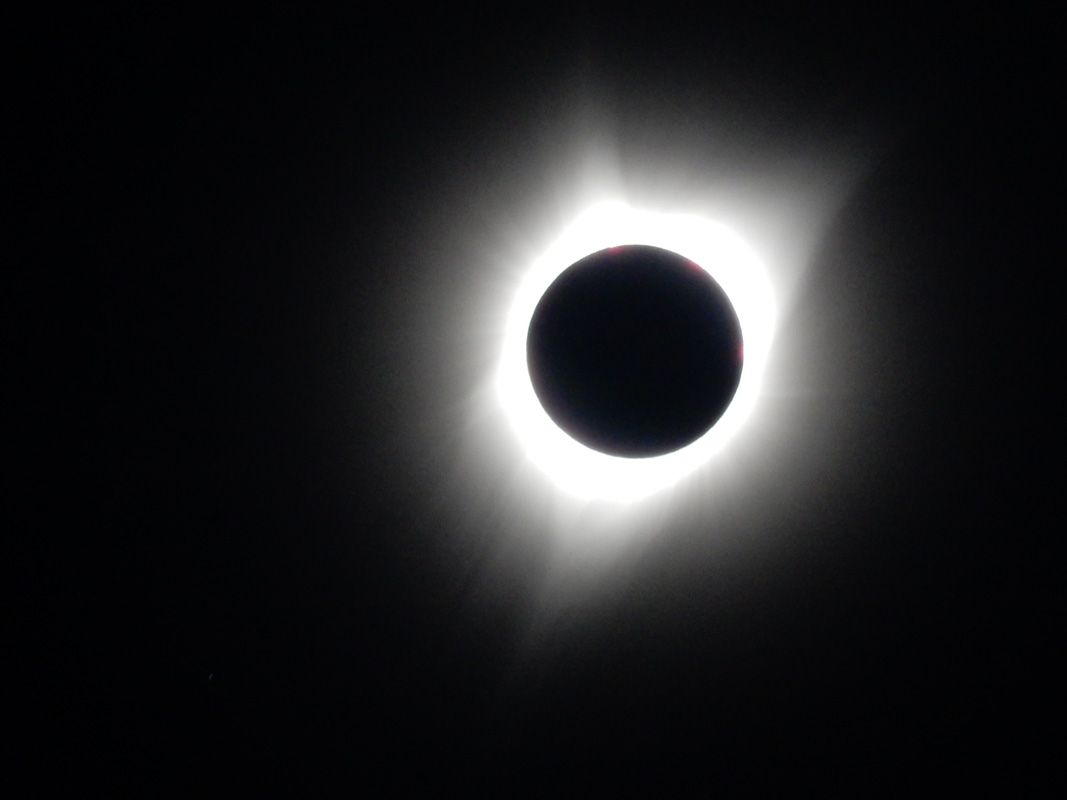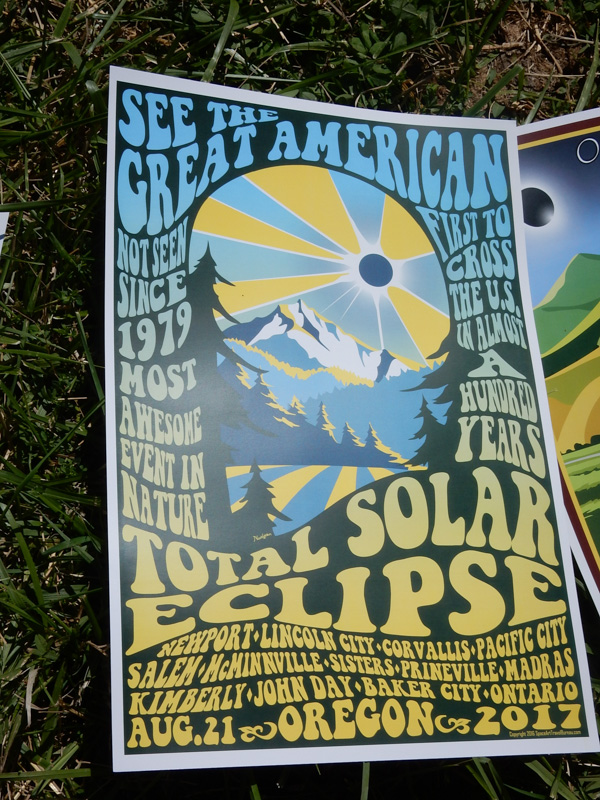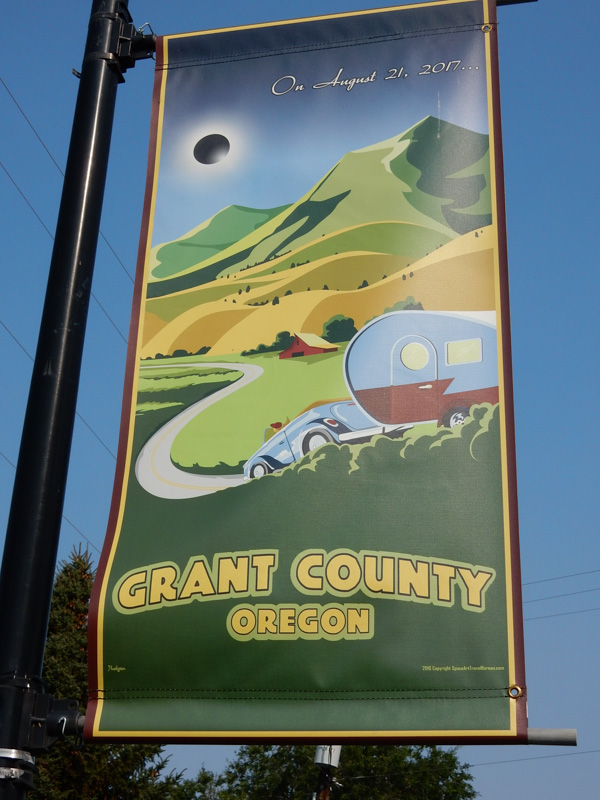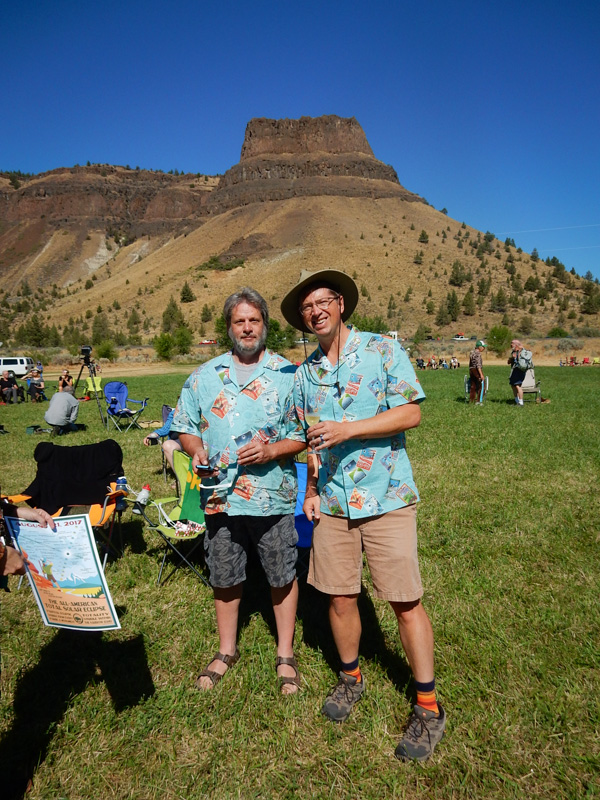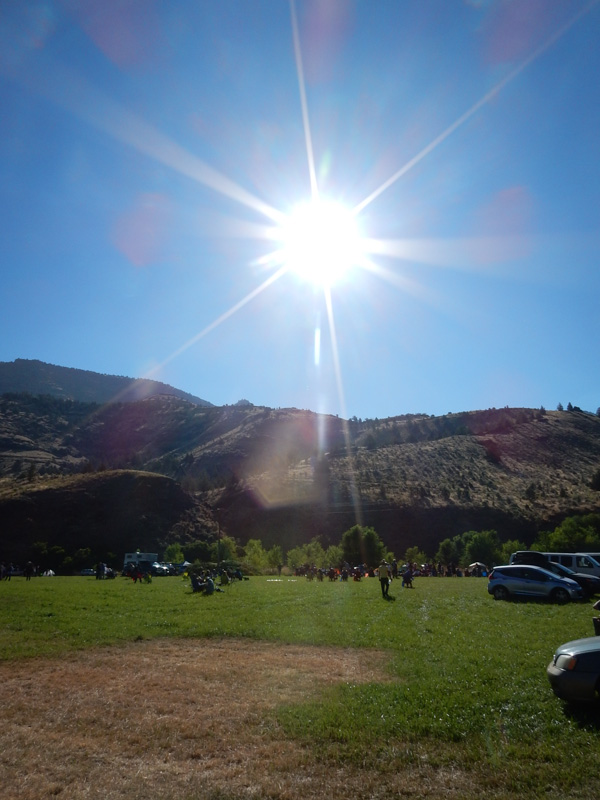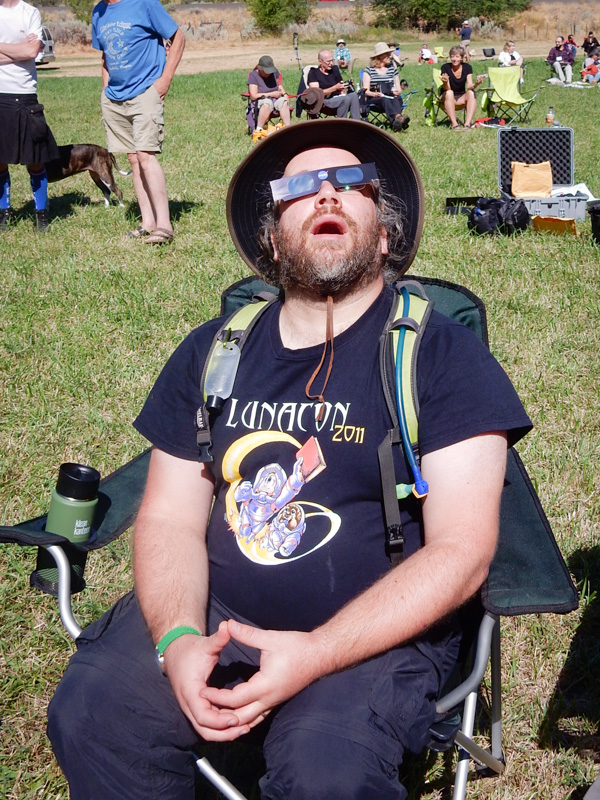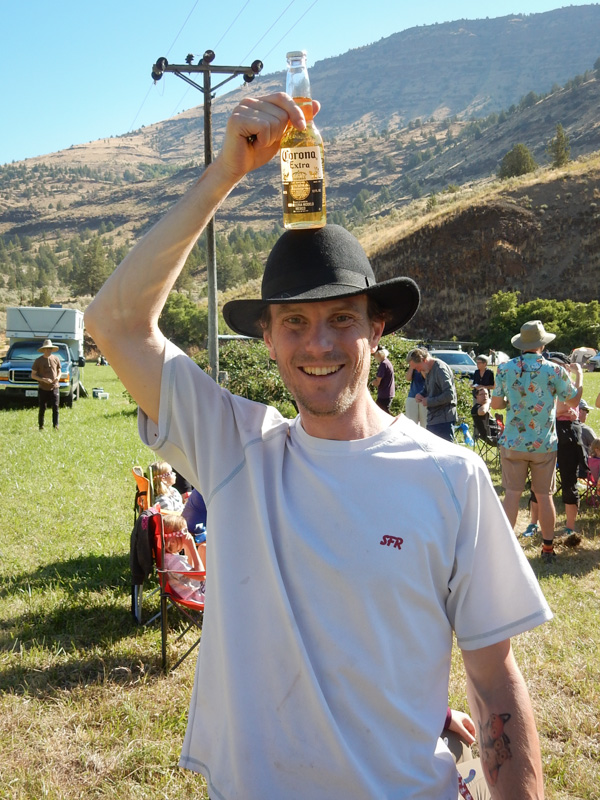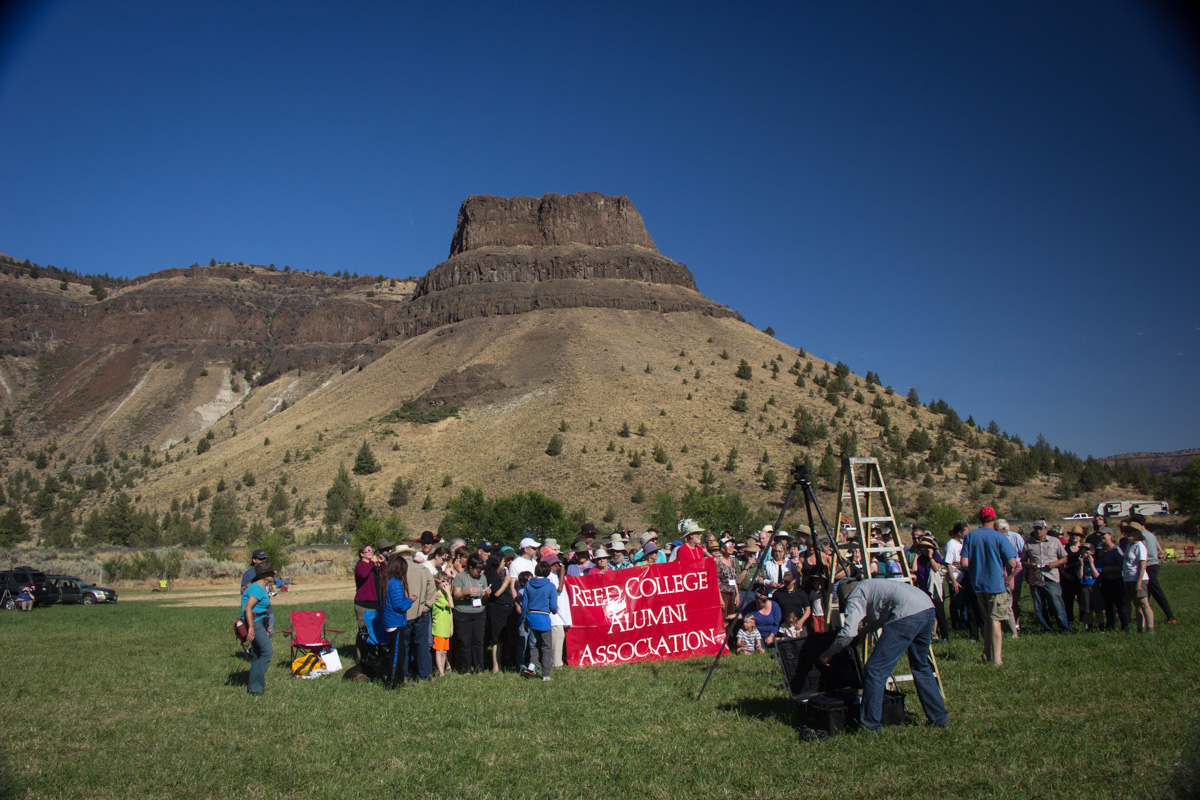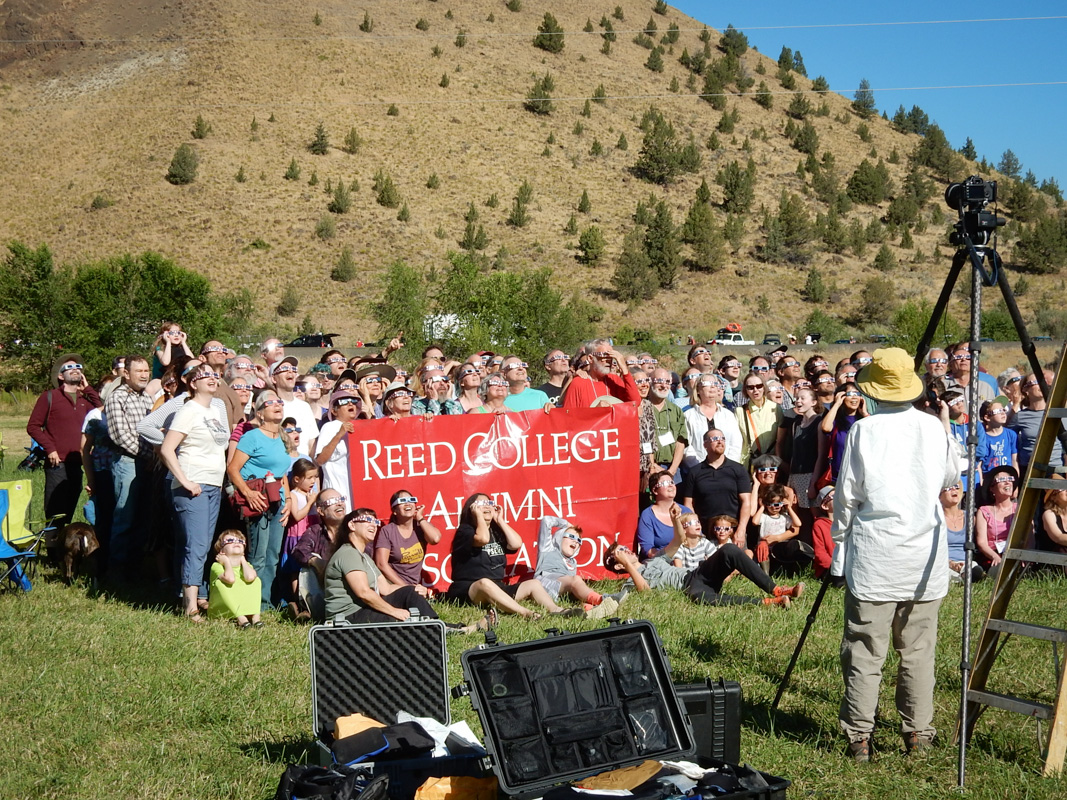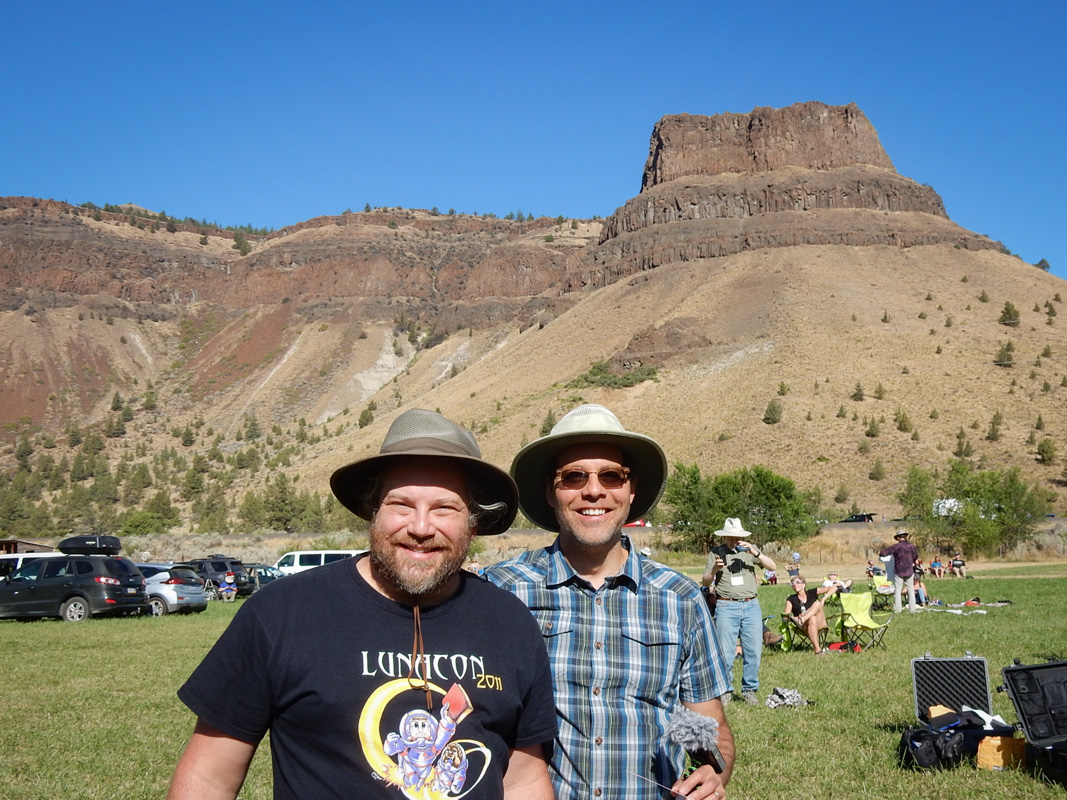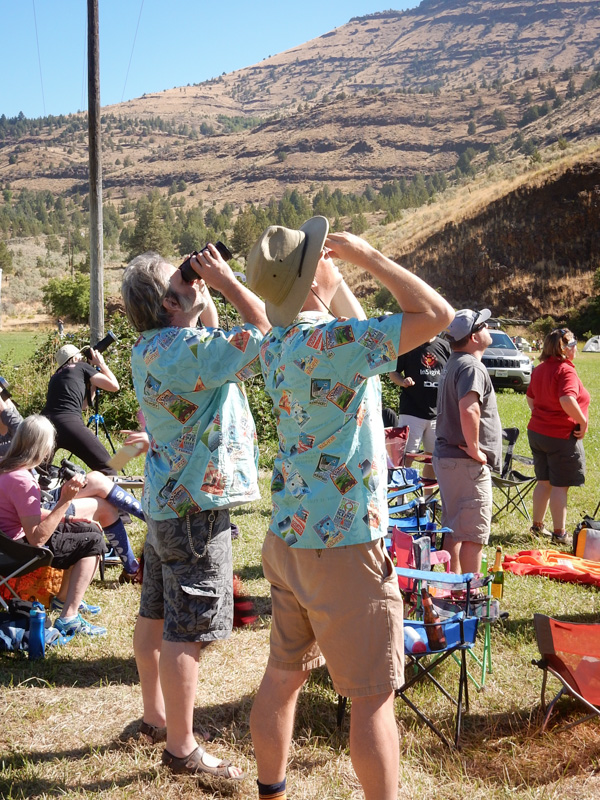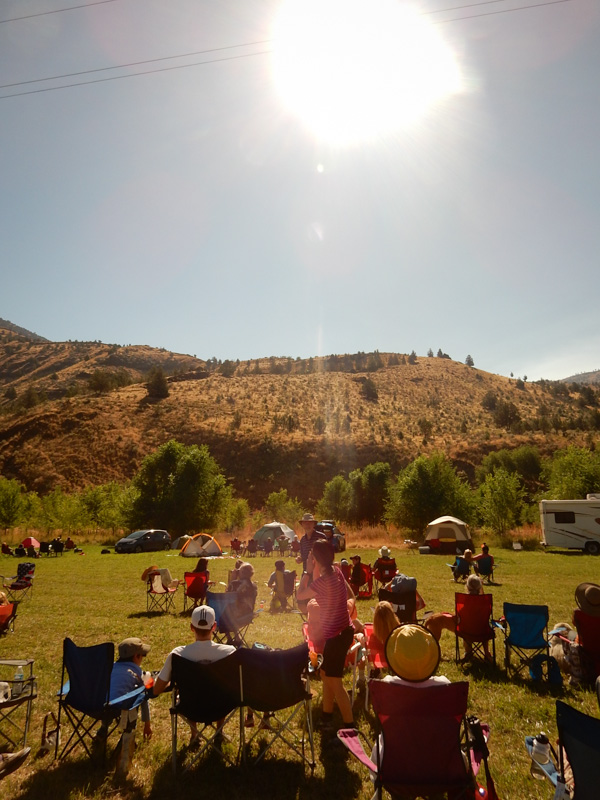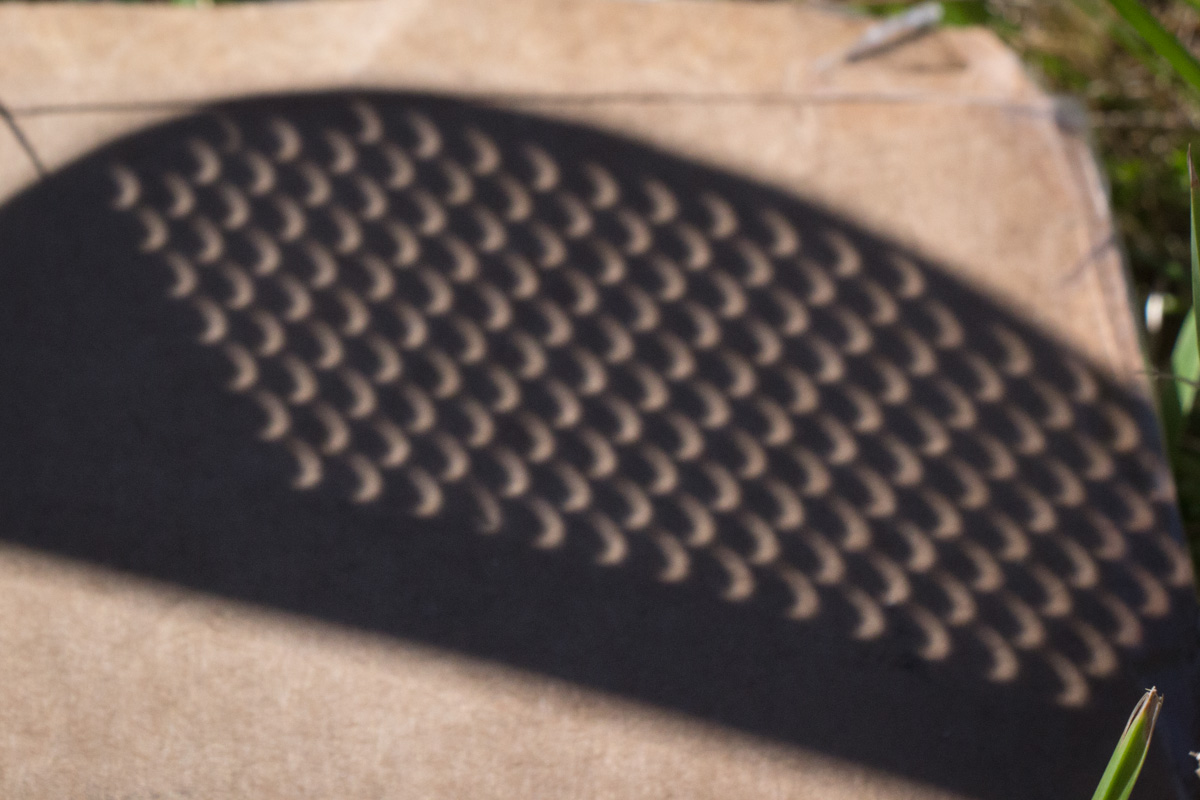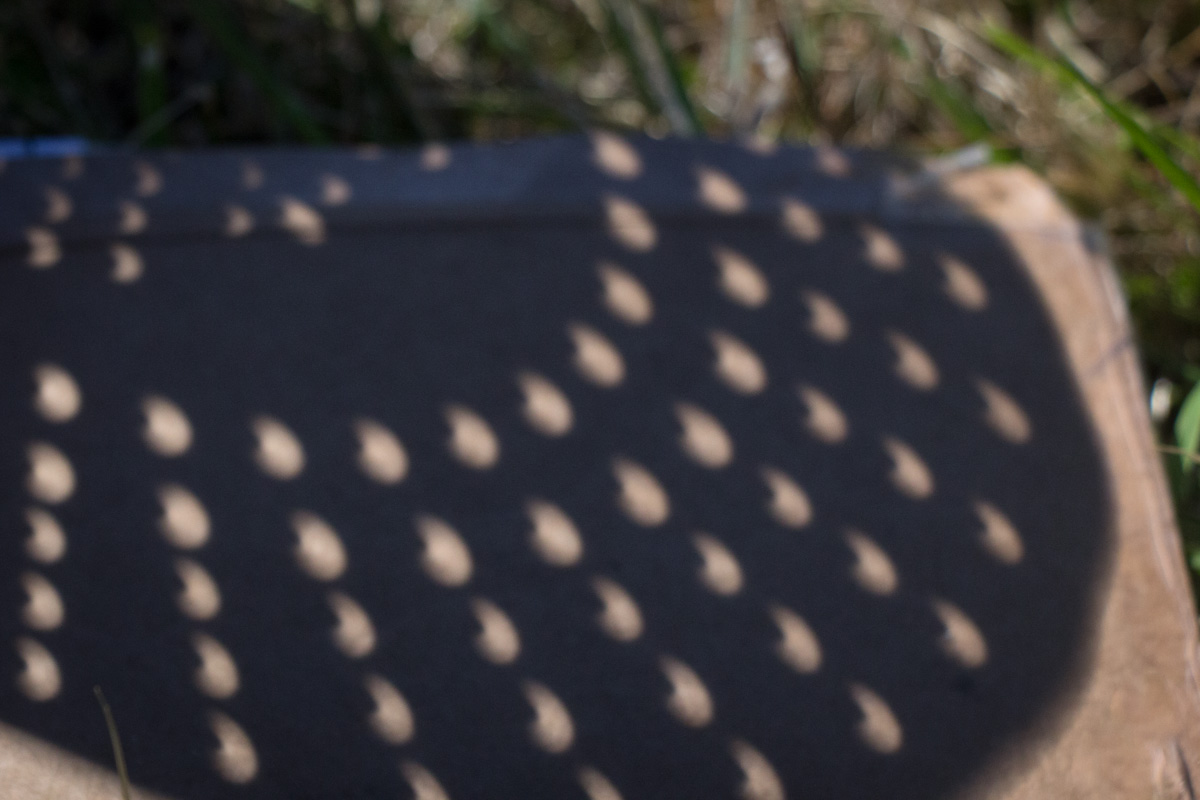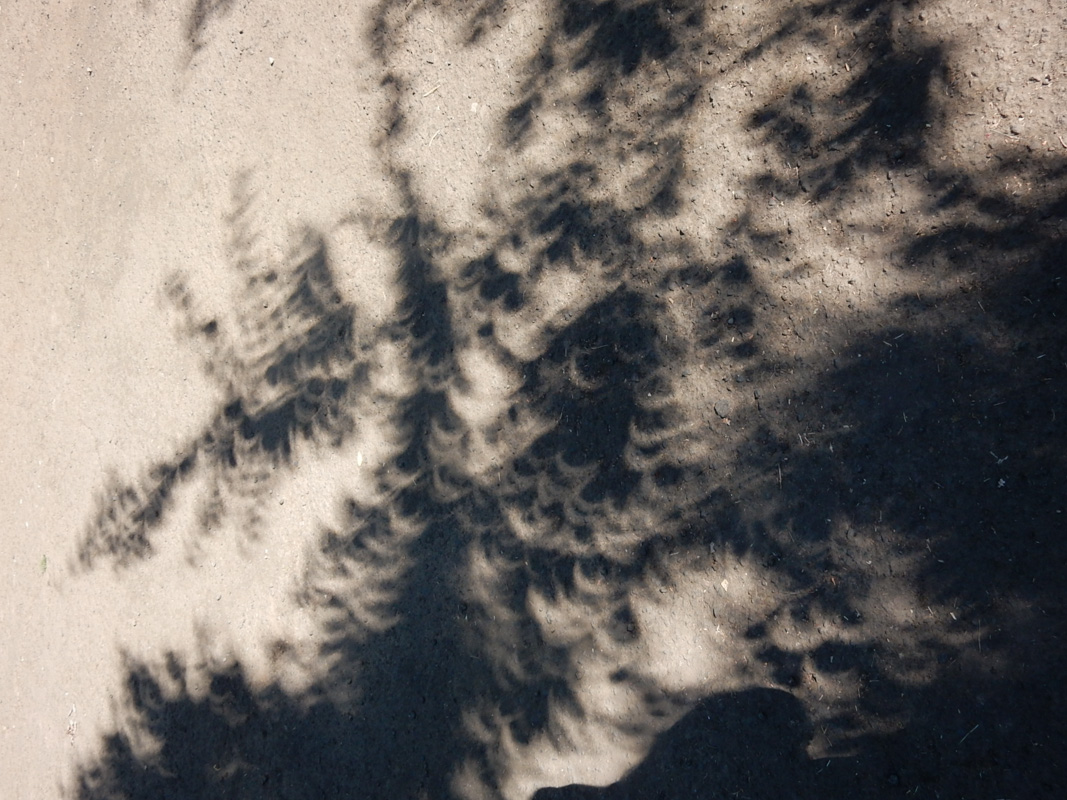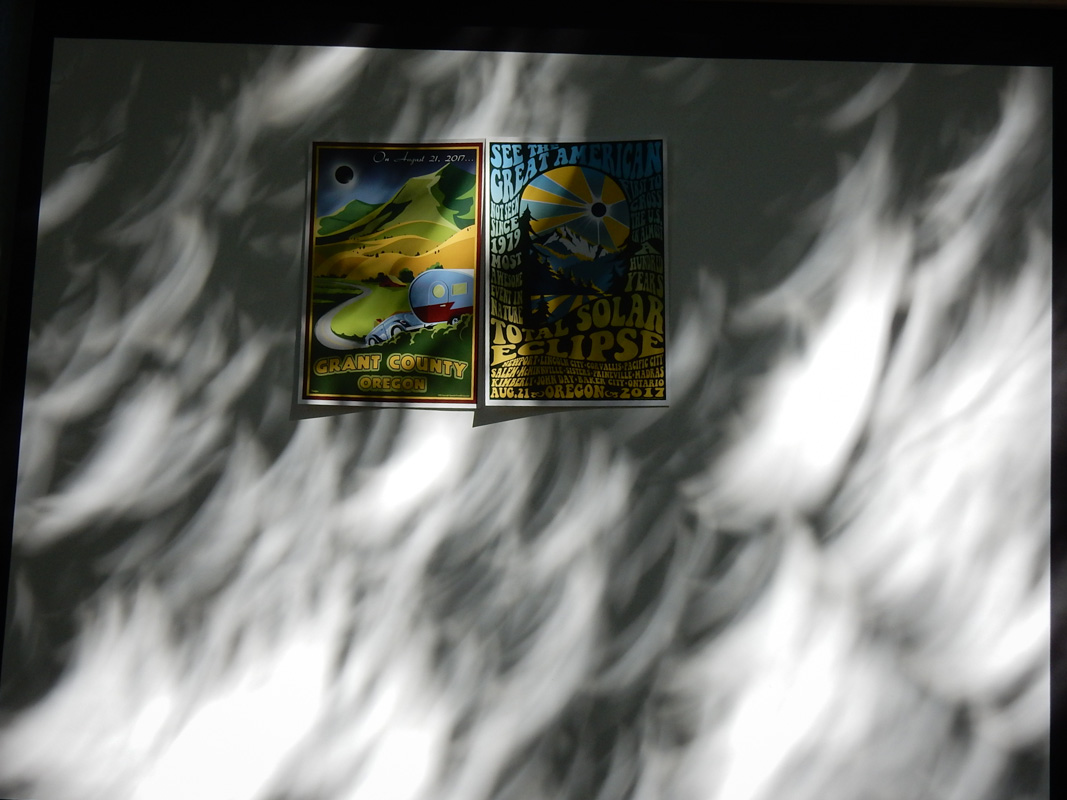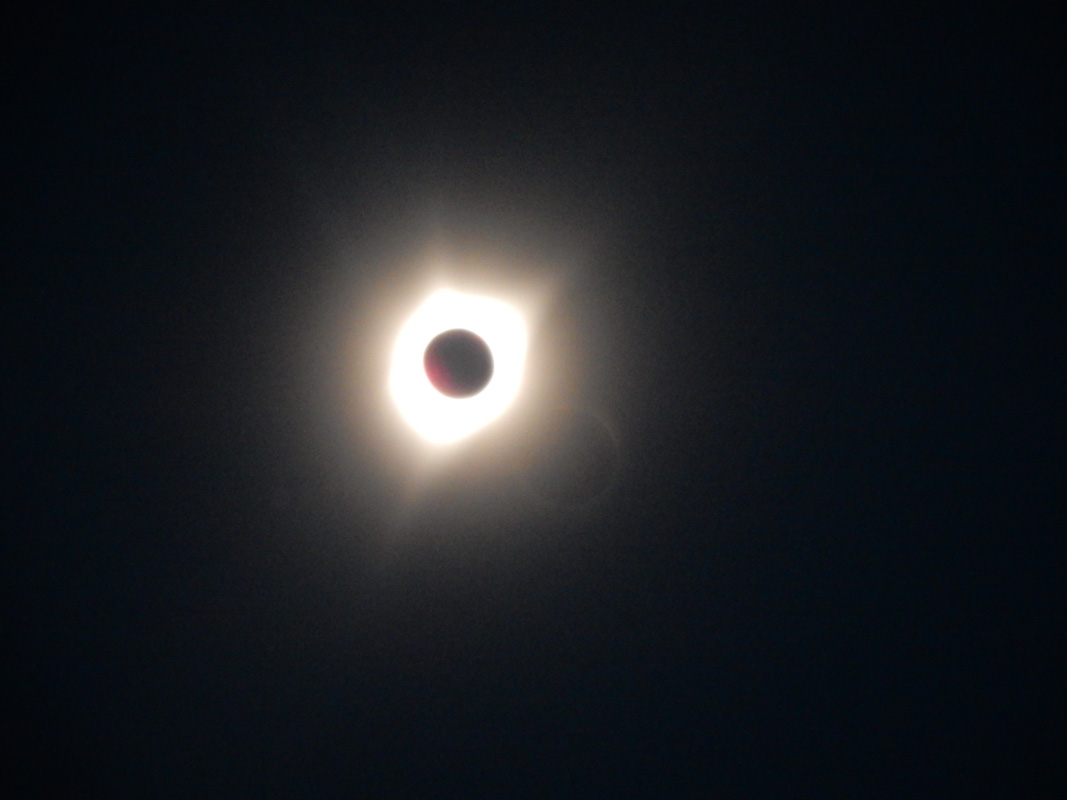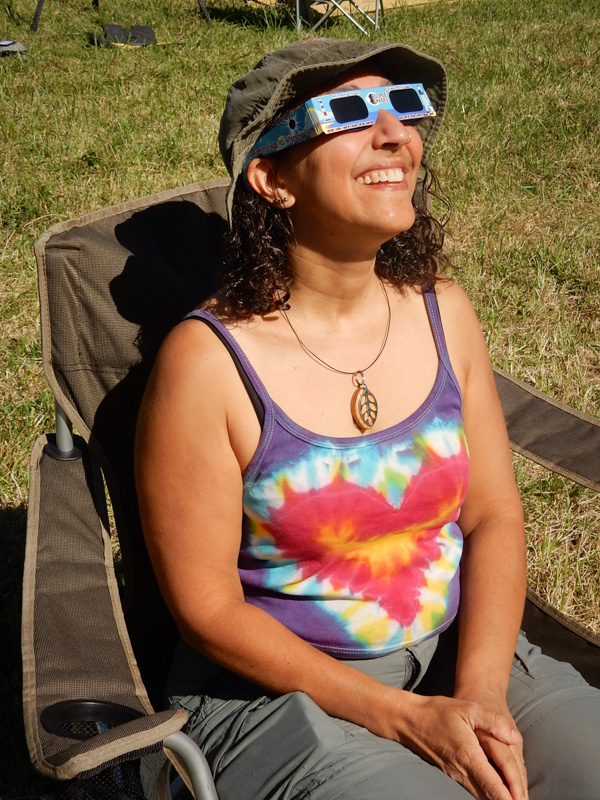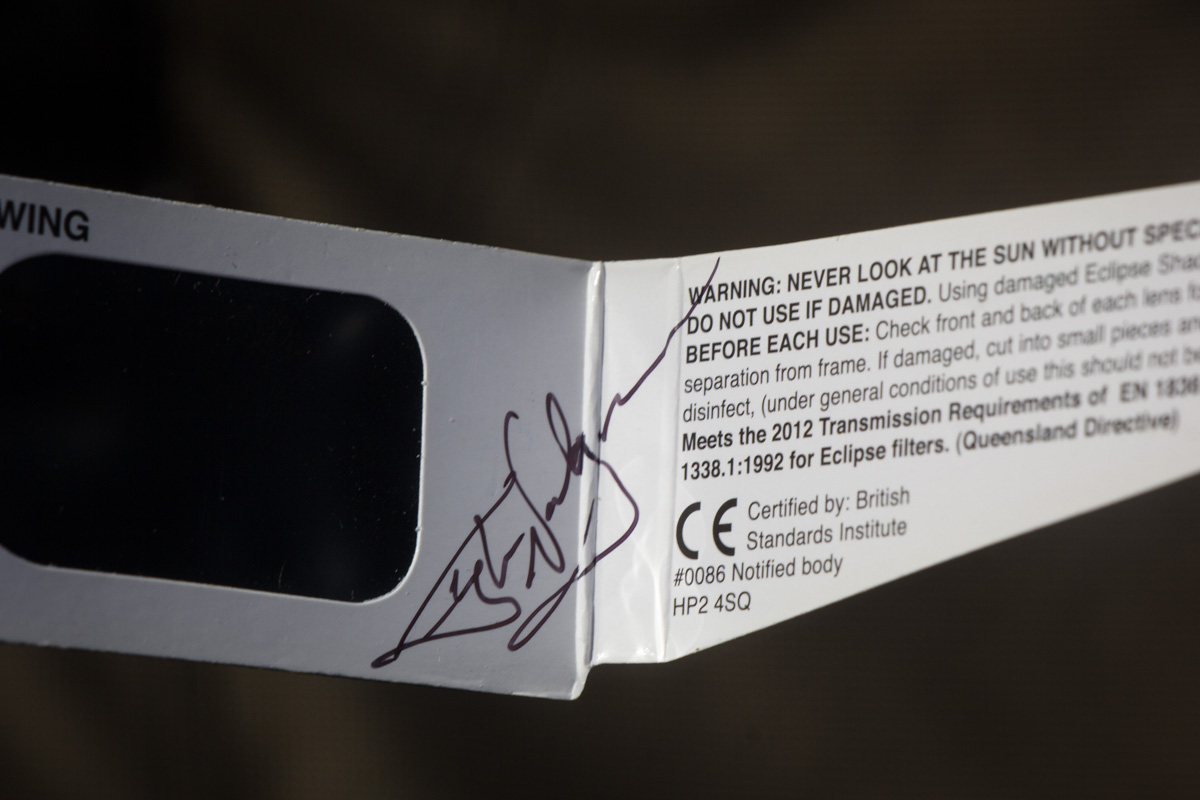2017 Great American Solar Eclipse
Monday 21 August, 2017
The totality. Photo by Eric.
Solar eclipses, both total and partial, have fascinated, awed, and scared humans throughout the history of humanity. They are literally an awe-some experience even if you entirely understand the science behind them and know the sun will return.
It's hard to believe how such an event could have been more special, but if anyone made this one more so, it was Dr. Tyler Nordgren, Artist - Astronomer - Night Sky Ambassador.
As I mentioned on the page about the ranch, Tyler is an astronomer at the University of Redlands. Tyler had gone all the way to the Faroe Islands for a 2015 eclipse. The skies had been clear, and then, because the eclipse lowered the air temperature, clouds appeared and, at the last minute, blocked the view. So, the eclipse eclipsed itself. So Tyler had been bound and determined to find clear skies from which to view the 2017 eclipse. His giddy excitement about the whole event was quite contagious. He just loved being the center of attention while surrounded by other astronomy geeks in a real "Nerdvana."
Sunday night after our delicious barbecue dinner, Tyler gave a presentation about the eclipse. He was introduced as a lover of the national parks, so he was immediately adorable. Wikipedia tells me that Tyler has been a member of the National Park Service Night Sky Team since 2007, promoting astronomy education in US National Parks. And here he was doing almost exactly that, since we were so close to a national monument. In addition to a book specifically on eclipses called Sun Moon Earth: The History of Solar Eclipses from Omens of Doom to Einstein and Exoplanets, Tyler has written a book called Stars Above, Earth Below: A Guide to Astronomy in the National Parks. I may need this book.
Tyler's presentation was excellent. He started out talking about his experience of a total solar eclipse as a nine-year-old home alone, how he'd been too scared to go outside, and took pictures of the event displayed on the TV. Later, he became fascinated enough by the stars to become an astronomer.
Tyler went on to describe in detail what would happen during the eclipse. Predictions for the weather were very good. The "first contact" would be around 9:08. At that point, with the eclipse glasses, you could look up at the sun and see a tiny bite taken out of it by the moon. This would be a moment of great excitement when we would all want to be out on the meadow to watch. The partial eclipse would go on for around 1:10, as the light changed and the sky gradually darkened. Shadows would develop crescent shapes, the temperature would drop, and birds would think it was nighttime and stop singing. Our senses of time would become distorted. But, this would go on for a while and would not hold a lot of people's attention. So, Tyler said, we all should set our phones to make an alarm at 10:10, and that, at that point, we should make sure we got together with our loved ones for the totality. Just before the beginning of the totality, we should be able to see the diamond ring effect, or Baily's Beads, when just a tiny bit of sunlight would escape around the edge of the moon, such that it would look like the diamond on a ring around the moon. Then the totality would be complete, and we would be able to take off our eclipse glasses and see the corona around the sun. It would be an unbelievably emotional experience, Tyler said. The totality would only last about two minutes, so we should just enjoy it rather than being distracted by trying to take pictures. If we wanted to take pictures, we should take pictures of crescent-shaped shadows and people enjoying the event during the period before the totality, because after the totality, we'd be popping champagne corks and too excited to operate our cameras.
Tyler went on to tell us about solar eclipses we might see in the future. In August 2027, there will be a total eclipse over Luxor Temple with six minutes of totality. "Just imagine watching six minutes of totality in Luxor Temple!" Tyler gushed. In March of 2033, there will be a total eclipse over Nome, Alaska, with a good chance of seeing aurora borealis during the event. More prosaically, there will be a total eclipse over upstate New York in April of 2024. Of course, on any given day in upstate New York, there's a fair chance of cloud cover. The indomitable Tyler is optimistic.
Tyler is not only an astronomer, he is also an artist. He had prepared some WPA-style posters for the eclipse event. Photo by Eric, who says that you've probably seen Tyler's work cross your Facebook feed, when his Trappist-1 poster went semi-viral.
Some of the local municipalities had put up signs with Tyler's art for the occasion of the eclipse. Photo by Eric.
Tyler also designed fabric with his eclipse poster art on it. Here he is (right) with his friend Bob Combs, with both of them modeling his Hawai'ian shirts. The posters, fabric, and clothes are for sale on Tyler's web site (or at least they will be when gets back home!). Photo by Eric.
Tyler sold and signed posters for a while in the barn, while I looked up at the supports for the barn roof and entirely understood why Katie from my trapeze class wanted to hang a trapeze in her tractor barn. Then he took us out into the meadow to look at the stars.
The sky was amazing. Far from the skyglow of the city, we could see a brilliant array of stars. We could clearly see the Milky Way. We could see the stars twinkling through the atmospheric distortion on the horizon over the ridge. It was so beautiful.
Tyler pointed out that some sections of the Milky Way appeared thicker than others because that was the direction of the center of the galaxy and there were more stars that way. There was also a section of the Milky Way that was blotted out by gaseous clouds between us and it. He also pointed out the Andromeda Galaxy, which looked just so cool through my binoculars! Tyler fielded many astronomical questions. He explained that the moon will not always been able to totally eclipse the sun, because it is moving further away from the earth. As the moon causes tidal distortion of the earth's sea floor, angular momentum gets transferred from the earth to the moon, and the moon swings out into a larger orbit. Eventually, it will be too far away to eclipse the sun entirely, and there will only be annular, or partial, eclipses. This situation is of course very far off in the future. While we were out in the meadow with Tyler, we saw several leftover Perseid meteors shoot through the sky. It was a true Nerdvana.
In the morning, we had our delicious breakfast, with more spectacular tomatoes, at 7:30, and headed back to camp for a quick solar shower. Sadly, we missed the first contact because I was stuck in the port-a-potty, and Eric didn't know where I had put the eclipse glasses. That was disappointing.
We gathered our chairs, binoculars, cameras, and eclipse glasses and headed out into the meadow where the others were gathered. As you can see, the weather was absolutely perfect. Photo by Eric.
We sat down and put on our eclipse glasses. Wow! There it was, a reddish sun, with the edge covered up by a dark shape! Someone let us look through her film-covered binoculars, and it was even more dramatic. It looked so much like all the pictures you've ever seen of an eclipse, it was hard to believe it was actually real.
Eric awed by the eclipse.
Eric was putting on sunscreen, and I remarked that putting on sunscreen for a solar eclipse was kind of a strange thing to do. Someone offered him a Corona in exchange for some sunscreen. Eric of course does not drink beer, but he took the guy's picture with his Corona.
The self-appointed Soundtrack Committee played Pink Floyd's Eclipse.
The Reedies posed for photos in front of the Wedding Cake.
Eric took one of them gawking at the eclipse in their glasses.
Amazingly, we ran into our neighbor and Eric's former co-worker, Dave. The world is so small!
Eric took a picture of Tyler and his friend staring up at the eclipse with binoculars.
Gradually, the size of the dark spot over the sun increased in size, the sky darkened, and the air around us cooled. The color of the light was strange and different. I didn't even try to photograph it, because I couldn't imagine I'd ever be able to get the white balance sufficiently correct to show it to you; it's too much of an unusual light and the software isn't designed to replicate it. Jo-Ann said that it looked like the dimness of sunset but without the orange-yellow glow. That seemed accurate.
Eric took a picture of the group gawking at the sun. You can see in his .jpg that the light looks very strange, but I don't think it is an accurate representation.
As the sun shrank to a crescent, we experimented with photographing the unusual shadows. I had brought along a pasta strainer and a silicone basket steamer for camp cooking, and we took pictures through the circles.
The pasta strainer.
The basket steamer.
Eric went back to the port-a-potties and took some pictures of the sunlight falling through the leaves of the trees.
Another of Eric's tree shadow photos.
Outside the barn, he took a picture of the shadows of the leaves falling on Tyler's posters.
Someone had set up a large projector and let me take a picture of the crescent in his display.
Then came the totality, and Tyler announced that it was safe to take off the eclipse glasses.
Oh, my. What an experience. It was unreal. Just what you were told to expect, and yet somehow entirely unexpected. The daytime darkness, with Venus visible above our heads. The corona shining around the edges of the sun. The dark spot that we knew was the moon. Wow. The event of a lifetime. We were so awed that Eric forgot to try to look around for other stars, and I forgot to pick up my binoculars and look at the totality through them.
I managed to keep my finger off the shutter button, probably because I would have needed to have changed lenses, metered, practiced all of those time-consuming bits of perfecting my art. Eric, with the pocket camera, was unable to resist the temptation to take a couple of pictures. The results were better than I would have expected.
Tyler had told us that we were at a low point in the sun's 11-year activity cycle, so we would be unlikely to see arcs shooting out around the sun. But still, I could see the corona around the sun spreading away not in a uniform arc, but streaking out more strongly in certain directions, with a fairly well-defined line on one side that you can see in Eric's introductory picture at the top of this page. Later, I asked Tyler what I had been seeing, and he explained that this was because of the magnetism of the particles and an actual physical effect, not an apparent effect due to the optics.
All too soon, the totality was over, an incredibly bright light emerged from the edge of the sun, and we had to put the eclipse glasses on again. People went from gasping and crying to whooping and cheering as Tyler and his wife popped the cork on a bottle of champagne and started pouring. The self-appointed Soundtrack Committee, right on the money again, played the Beatles' Here Comes the Sun.
Eric was shocked that, mere minutes after totality ended, while the eclipse was still going on, he heard traffic going by on the road behind us. People trying to beat traffic, I suppose. We were very glad we had made the choice to stay one more night on the ranch and did not have to go anywhere anytime soon, and we could just sit back and enjoy the rest of the partial.
Eric took a picture of me basking in the glow of the eclipse, brimming with joy.
Eric and I both had incidents where we didn't get the glasses on completely and saw tiny bits of the bright sun. If we injured our retinas, we may not know for decades. If I injured a retina, it was in my shooting eye, and I'll have to learn to shoot with the other one.
Our Reedie friend Fawn had the brilliant idea of asking Tyler to sign her eclipse glasses. I got him to sign mine, too, before he decided he wanted to enjoy himself and not work so hard anymore.
As we had missed the first contact, Eric and I were determined that we were going to see the bitter end of the eclipse. As others gradually packed up their chairs and went back to camp (the Reedies needed to catch buses back to Portland at 12:30), we sat in our chairs with our glasses on and stared into the sun. Many minutes passed when we could see a smaller and smaller sliver of moon. After we finally removed our eclipse glasses, Tyler said he could still see a sliver of moon through his binoculars. At last, around 11:30, he announced that the eclipse was over.
"I'm great on an ordinary day, but today I have been awesome!" Tyler announced. "Tomorrow I have to go back to being just a regular guy!"
We thanked him, bid our goodbyes to our new friends from Reed, and went back to camp for a delicious lunch of grilled cheese sandwiches with Jody's amazing tomatoes, cooked in cast iron on our fabulous new stove. While many people fought what traffic there might have been, we relaxed in camp, chatted with other campers, and admired the mules. We spent most of the afternoon in the shade of the trees, me processing photos while Eric napped. My normally incredible sense of time had indeed been severely distorted by the eclipse. We had a tasty early dinner, also cooked in cast iron on our fabulous new stove, and went to bed the crack of dusk, around 20:30, so that we could get up at 5:00 in hopes of striking camp and getting on the road by 8:00 (we actually made it by around 8:20).
This was all an amazing, awe-inspiring, indescribable experience. I'm so glad we managed to pull it off, and that we lucked into such a friendly place from which to observe in true Nerdvana. To prove the point about just what a Nerdvana this whole event was, on the way out of Oregon and returning to California, we saw some people stopped by the side of the road, one taking a picture while the other held two gnomes up in front of the "Welcome to Oregon" sign. We laughed our heads off.
This was absolutely our best camping trip ever! Even back in California, I am still aglow with joy.
